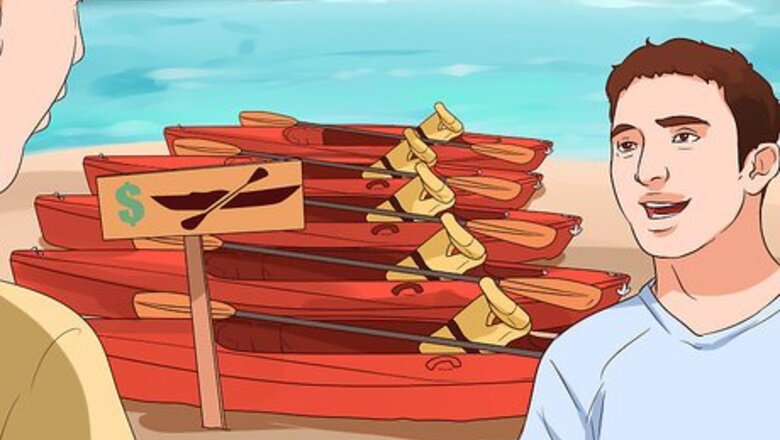
views
Paddling Forward
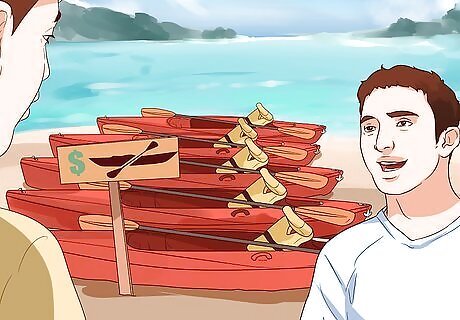
Buy or rent proper safety equipment before starting. Like all aquatic activities, safety is very important while canoeing, so make sure you have the proper equipment before you set off on your canoeing adventure. Though rare, hazards like drowning are, tragically, no joke. Below are bare minimum equipment recommendations — contact your local outdoors authority (like, for instance, a park ranger's office) for specific information regarding the area you plan on canoeing in. Also, see the "Things You'll Need.Paddle a Canoe Step 1 Version 4.jpg In addition, you'll want to be at least a reasonably competent swimmer, as capsizing (having the canoe flip over) can be a frequent problem for beginners.

Maintain a low center of gravity to balance in the canoe. The very first time you climb into a canoe, you're likely to immediately notice that balancing is difficult and that every small movement seems to shift the boat more than expected. To counteract this rocky feeling, stay as low as possible — you can even sit or kneel in the bottom of the boat until you feel more stable. Most canoes' seats should provide fine balance as long as you aren't moving around or standing up. If you are paddling by yourself, sit in the back (stern) with your gear at the front (bow) so that you'll be able to steer the boat. If you don't have much gear, you may find it easier to balance by sitting in the center. Try to sit up as straight as possible in your seat. Keeping your body perpendicular to the surface of the water (usually, this means straight up and down) gives you the stablest balance. Don't worry! The boat will be more stable when paddle/s are in the water, as the resistance from the moving water helps to keep the boat upright.
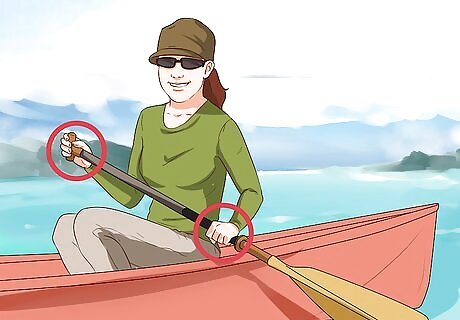
Grip the paddle with one hand on top and the other a few feet down. Seated securely in the boat, grab a paddle with both hands. Put one hand on top of the end of the handle (there should usually be a rounded portion here; if there isn't, grip the handle near the top.) This will be referred to as your boat-side hand. Use your other hand to grab a lower point on the handle that's comfortable for you. Usually, this will be at least a foot or so above the flat part of the paddle — gripping right next to the flat part isn't advised as it forces you to work harder. Turn your hand so that your lower palm is facing toward the boat. This will be referred to as your water-side hand.
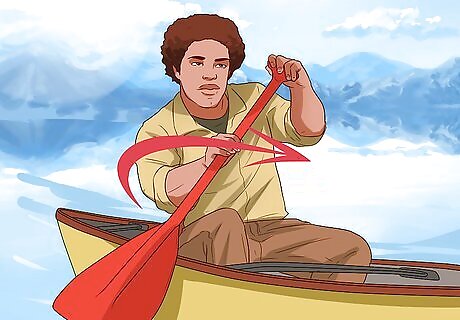
Reach forward with your paddle. It's time to begin your stroke! Start by twisting at the torso so that your water-side shoulder shifts forward. Move the paddle forward (out of the water), then plant it in the water so that the blade of the paddle (but not much of the handle) is submerged. Keep the shaft of the paddle as close to vertical as possible for greater strength. Don't forget your body position as you paddle. You want to reach as far ahead as you can without moving from your seat or leaning too far forward. This will put you off-balance.
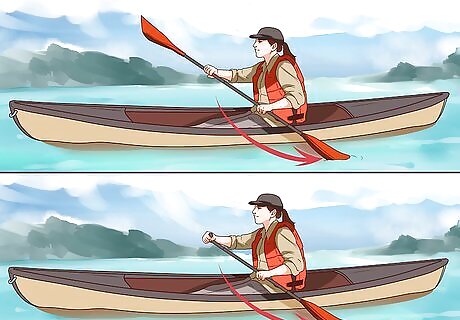
Pull the paddle back towards you. Turn the blade of the paddle so that it is perpendicular to the boat (and the direction of travel.) Use your arm and core muscles to pull the paddle through the water in a straight line parallel to the centerline of the boat. Try to keep the paddle close to the boat as you make your stroke (some sources even recommend keeping the inside edge of the paddle touching the canoe). Having a wider stroke can inadvertently make the boat turn. Muscle discipline is important for efficient paddling. You want to be using mainly the core muscles of your body for power, not your back muscles, as using the latter can leave you sore and uncomfortable after your boating trip.

Restart the paddling motion at your hip. Stop applying power to the paddle when the blade reaches your hip. Begin to bring the blade up and out of the water. Turn the paddle so the blade is parallel to the surface as you move it forward for the next stroke. You are now back at your starting position! Simply repeat the steps above to continue paddling — the canoe should gather momentum and move forward at a good speed. However, if you paddle only on one side of the boat, you'll start going in circles. See below for information on cross-paddling.
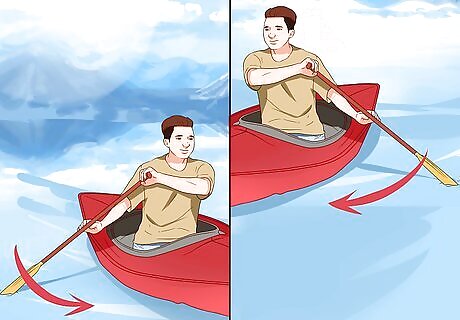
Switch the side you paddle on every few strokes. If you've ever seen someone paddle in a canoe, you've probably noticed that she will pull the paddle out of the water every few strokes and start paddling on the opposite side. This is to keep the canoe going in a straight line — paddle on only one side and you'll notice yourself start to turn to the side opposite your paddle. To cross, pull the paddle out of the water when it is at your hip. Lift it perpendicular to the boat and bring it across while switching the position of the top and bottom hands — this should feel natural. Insert it into the water and paddle as before. Try practicing this a few times to get a feel for the "rhythm" of when to switch sides. For most, switching after every few strokes is best — the exact number will vary depending on your paddling form and how hard your strokes are. If you're paddling tandem (i.e., with two people in the canoe), you'll want to coordinate the switch with your partner. See below for information on paddling with a partner.
Steering

Paddle on one side continuously for gentle turns. The simplest way to turn a canoe is probably the most intuitive — assuming you are sitting in the stern (rear) or center of the canoe, simply paddle as you normally would on one side to eventually start turning in the opposite direction. That is, to turn left, paddle on the right side, and to turn right, paddle on the left side. You should notice the course of the boat change slightly with each stroke. This method is great for gentle corrections in course because, while it doesn't turn the boat quickly, it doesn't slow you down either. For instance, if you see a sandbar jutting out of the water 100 meters (330 ft) ahead, it's probably appropriate to use this turning style to get around it — you're in no hurry.

Use "J" strokes for more controlled turns. While canoeing, you'll eventually find that, while paddling on one side of the boat is an effective way of steering in many situations, there are plenty of times when quicker turns are required. One of the simplest ways to turn is called a J stroke. To use this technique, you'll ideally want to be sitting in the stern of the boat. To do a J stroke, put your paddle into the water behind you so that it is nearly flat against the side of the boat, which it should be almost touching. As you do this, twist your torso so that your shoulders point parallel to the sides of the boat. Use your core and torso muscles to turn back to a forward-facing position — this should make the paddle turn out to the side a little and the boat should turn to the same side as the paddle is on, just like if you were using a rudder. Avoid over-using this stroke. While it will make you turn quickly, it will also slow down your forward momentum.
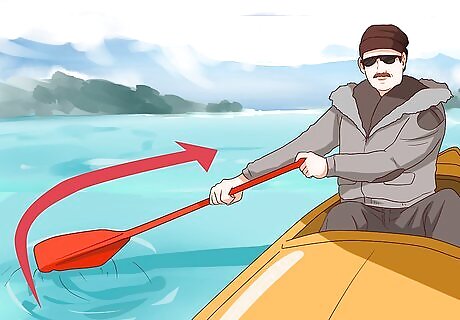
Use large back sweeps for sharp turns. The J stroke discussed above is actually just a smaller version of a special paddle technique called a "back sweep." By increasing the size of the back sweep, you'll increase the speed at which you turn. However, larger back sweeps will also make you slow down more, so you'll want to reserve them for situations when you need them or you'll have to paddle hard to build up speed again. To do a back sweep, start out with your paddle behind you as you would for the J stroke. This time, as you straighten your torso, let the paddle swing out completely to the side — it should be perpendicular to the side of the boat when you finish the motion. You should immediately notice the boat turn to the same side as the paddle is on.
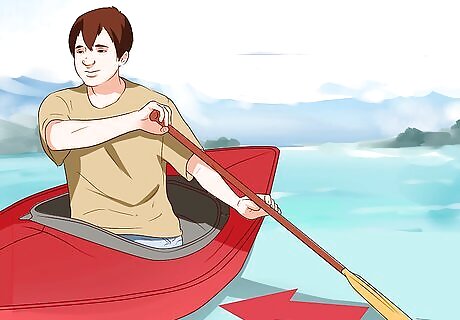
Alternatively, use draws for sharp turns. Another technique for making sharp turns in your canoe is called the "draw." This technique is effective, but since its form is different from any of the other strokes, it can be more awkward to execute while moving unless you're an experienced paddler. Try testing it out at slow speeds before using it in a serious situation. To do a draw, plant your paddle in the water directly out to your side. Your arms should be as straight as possible, the paddle should be as vertical as you can keep it, and your boat-side arm should be over your head. Pull the paddle toward the boat until it touches or is very near to it, keeping its blade parallel to the side of the canoe as you do so. Assuming you are sitting in the stern, the canoe should turn to the side opposite the paddle. Remove the paddle from the water by slicing it backward out of the water without changing the orientation of the blade. From here, you can transition easily into a standard forward stroke or a J stroke.
Paddling with a Partner

Sit at opposite ends of the canoe. Paddling in tandem (with a partner) is similar to paddling on your own, with some crucial differences. When two people are sitting in the same boat, it's important to keep the boat "trim" — that is, to make sure it sits balanced in the water. Thus, you'll want one person sitting at the bow (front) of the boat and the other at the stern (back). This should be the sitting arrangement that feels most natural and balanced. If one person is significantly heavier than the other, you may want to consider putting more of your gear at this person's end of the canoe to evenly distribute the weight. In traditional canoe terms, the person sitting at the bow is called the bowman and the person at the stern is called the sternman.
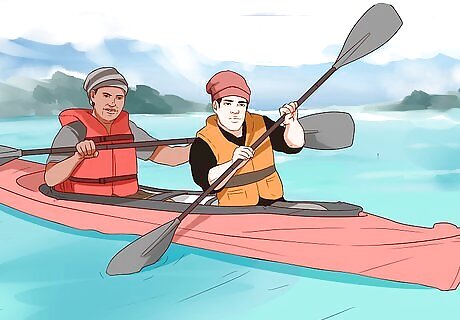
Let the bowman set the pace. When paddling as a team, you want to synchronize your strokes (start and finish them at the same time) to get maximum power. Since the bowman is facing forward and can't see the sternman, the bowman sets the pace. This means it is up to the stern man to match his strokes to the bowman's, not the other way around. Of course, both paddlers can (and should) talk to each other to figure out a comfortable pace — good communication is key for a quick, happy voyage.
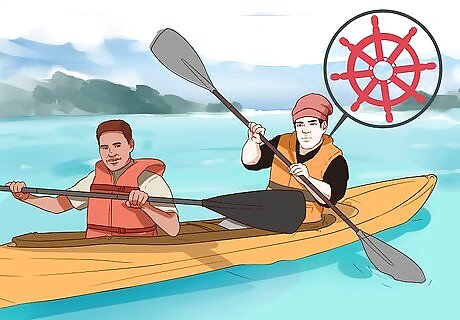
Let the sternman handle steering. The person sitting in the stern of the boat will almost always have an easier time determining the direction of the boat than the person in front. Thus, the sternman is responsible for making sure the boat is going in the right direction. She should use her normal strokes as well as special techniques like J strokes and sweeps to keep the boat pointed forward. The bowman may assist in turns, but will not usually be able to take a leading role. The reason that the sternman has greater control over the boat's steering has to do with the force of resistance the water puts on the boat. Essentially, since the bow of the boat is responsible for "cutting" through the water, it is constantly feeling the resistance of the water that it pushes out of the way. The stern, on the other hand, doesn't have this problem, so it usually feels less of a "push" from the water around it, making it easier to turn.
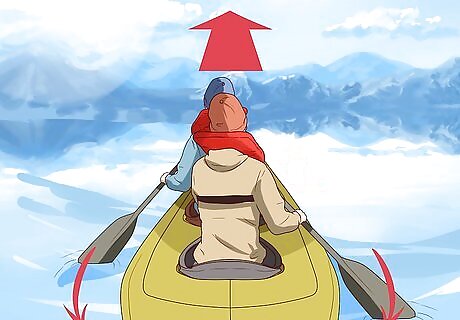
Synchronize your side-switching to travel in a straight line. When traveling forward, having both people paddle on opposite sides of the canoe generally gives the straightest result. To make sure you don't accidentally start paddling on the same side of the boat and cause it to turn, make sure to switch sides at the same time. Generally, the sternman calls out "switch!" when it is time to do so. Note that, since the sternman has greater control over the direction of the boat, the canoe will usually gradually turn away from the side the sternman is paddling on even if the bowman is paddling on the opposite side — this is why switching sides is important.

Be aware of differences in steering techniques for the bowman. With the addition of a second paddler, steering a canoe becomes slightly different. While all of the stern man's steering techniques described in the section above will work as normal, the bowman's efforts to steer can work differently because of his position at the front of the boat. If the bowman understands these differences, he can assist with the steering of the boat. Below is a summary of techniques the bowman can use to help steer: Paddling forward works normally (the boat will turn away from the bowman's paddle.) Draws work backwards (the boat will turn towards the bowman's paddle.) Instead of doing back sweeps, bowmen usually use a technique called the front sweep to help steer. This is essentially the opposite of a back sweep — the bowman reaches forward with the paddle, then pulls it back and out to the side in a wide arc along the surface of the water. This works like a stronger version of the ordinary forward stroke, turning the boat away from the bowman's paddle.



















Comments
0 comment